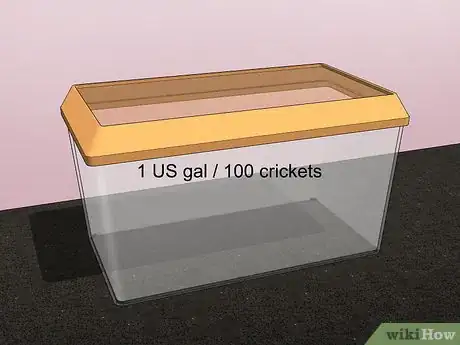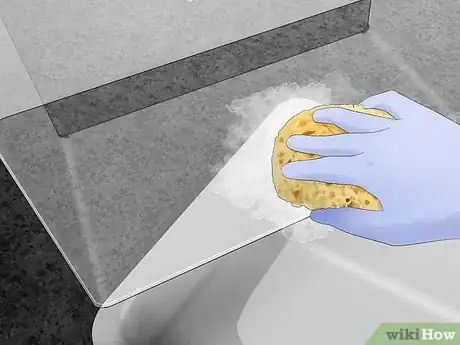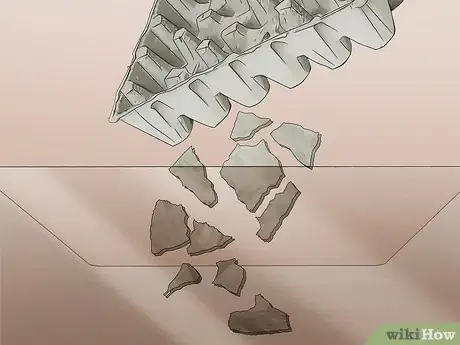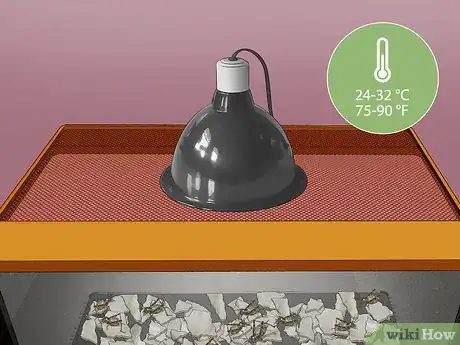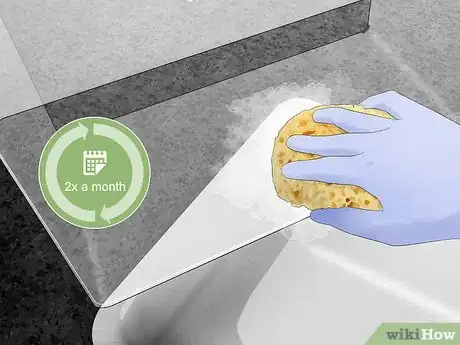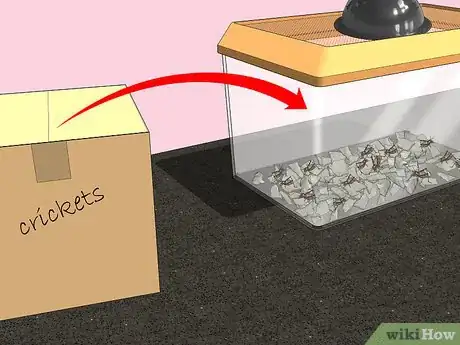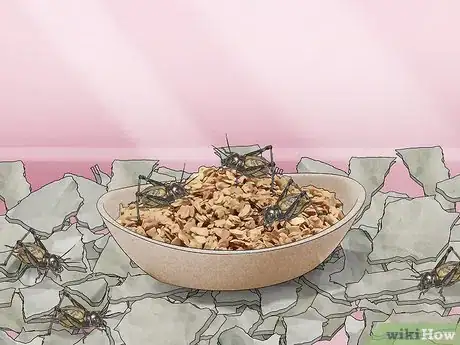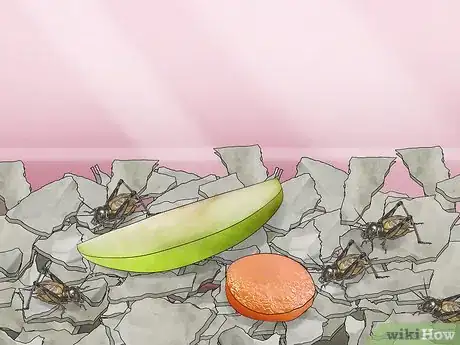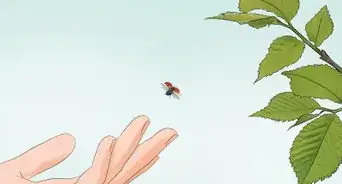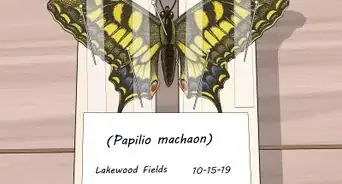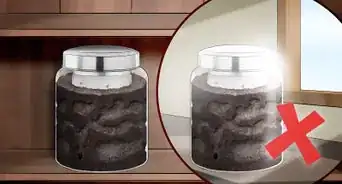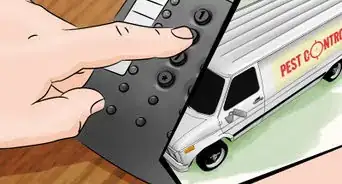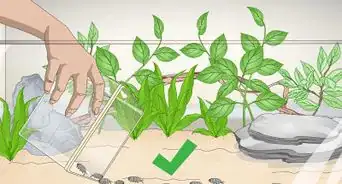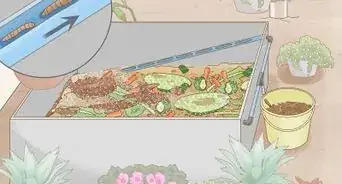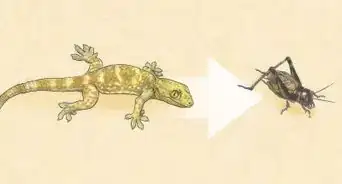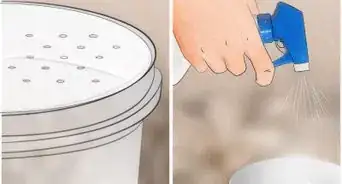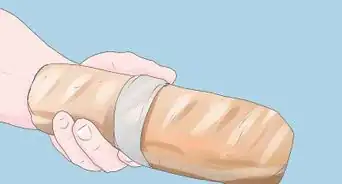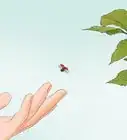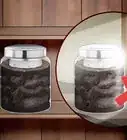This article was co-authored by Samuel Ramsey, PhD. Dr. Samuel Ramsey is an Entomologist and a researcher with the United States Department of Agriculture. Dr. Ramsey has extensive knowledge of symbiosis and specializes in insect disease spread, parasite behavior, mutualism development, biological control, invasive species ecology, pollinator health, and insect pest control. He holds a Bachelor’s degree in Entomology from Cornell University and a Ph.D. in Entomology from the University of Maryland. Dr. Ramsey’s research on bees has enabled researchers to develop targeted control techniques to restore honey bee populations worldwide. He also hosts a YouTube series called “Dr. Buggs.”
wikiHow marks an article as reader-approved once it receives enough positive feedback. This article received 33 testimonials and 92% of readers who voted found it helpful, earning it our reader-approved status.
This article has been viewed 496,753 times.
If you don’t properly house and care for your crickets, they may get unhealthy and die. Luckily, creating a healthy environment can be easy if you follow the right steps. First, you’ll have to get a clean tank or habitat that’s large enough for your crickets. Then, you’ll have to regularly feed them and provide an adequate water source to keep them healthy. If you do everything correctly, your crickets can live to be 8-10 weeks old!
Steps
Creating a Healthy Environment
-
1Get a tank that's 1 US gal (3,800 ml) per 100 crickets. Crickets thrive in larger environments, so get the largest tank that you can find to house them. Make sure that the tank you get has adequate ventilation on the roof. The tank should be enclosed so that the crickets can’t jump out of it.[1]
- You can get a plastic or glass tank.
-
2Clean the tank with a mild bleach solution to remove bacteria. Before you put the crickets into the tank, make sure that it’s cleaned. Mix a small amount of bleach with cold water. Dampen a rag with the solution and use it to wipe down the inside of the tank. Make sure the tank is dry before housing your crickets.[2]
- An unclean tank may contain harmful bacteria or chemicals that could make your crickets sick.
- Do not use other chemical cleaners as they could be harmful to the crickets.
Advertisement -
3Add torn-up egg crates to the tank so your crickets have shelter. Get a few cardboard egg crates and tear them up into pieces. Then, place the pieces on the bottom of the tank to create a habitat for the crickets. This will give the crickets shade and the space they need to thrive.[3]
- Without the proper habitat, crickets may fight each other for space.
-
4Keep the cricket tank between 75–90 °F (24–32 °C) at all times. Keep the crickets in a dark area that maintains a steady temperature to encourage healthy crickets. If the temperature in the tank is too cold, crickets will die and eat each other. If the temperature is too hot, the crickets lifespan will be shortened.
-
5Clean the tank twice a month to keep your crickets healthy. Carefully remove the crickets and place them in another box with breathing holes. Wipe down the bottom of the tank, making sure to remove any feces or dead crickets that remain. Then, use your diluted bleach solution and a rag to wipe down the inside of the tank to sanitize it.[4]
- Dead crickets and feces can make your crickets sick.
-
6Transfer new crickets to their habitat as soon as you get home with them. Crickets don’t do well in small, confined spaces. Don’t keep the crickets in their carrying box for too long or they may die. Transfer them to a clean tank as soon as you get home.[5]
- Make sure there are adequate air holes in the top of the box that you use to transport the crickets.
Caring for Your Crickets
-
1Feed your crickets oatmeal, cornmeal, or cricket food. Put cornmeal, oatmeal, or cricket food in a dish in the tank. Your crickets will feed off this food for a regular source of nourishment and won’t typically overeat.[6]
-
2Provide a damp sponge or piece of fruit as a water source. Crickets can drown very easily in a small dish of water. For this reason, it’s best to provide water from another source like a sponge or a piece of fruit like an apple or peach. Crickets will be able to suck out the moisture from the sponge or fruit.
-
3Keep food and water in the tank at all times. A food and water source should always be kept in the tank so that your crickets can feed and drink when they need to. Keep the food fresh by throwing it out and filling it back up once a week. If you use fruit, make sure that you replace the fruit every day so that it doesn’t rot or create bacteria in the cricket tank.
- Crickets won't overeat, so don't worry about overfeeding them.
Expert Q&A
Did you know you can get expert answers for this article?
Unlock expert answers by supporting wikiHow
-
QuestionDo crickets need high humidity?
 Samuel Ramsey, PhDDr. Samuel Ramsey is an Entomologist and a researcher with the United States Department of Agriculture. Dr. Ramsey has extensive knowledge of symbiosis and specializes in insect disease spread, parasite behavior, mutualism development, biological control, invasive species ecology, pollinator health, and insect pest control. He holds a Bachelor’s degree in Entomology from Cornell University and a Ph.D. in Entomology from the University of Maryland. Dr. Ramsey’s research on bees has enabled researchers to develop targeted control techniques to restore honey bee populations worldwide. He also hosts a YouTube series called “Dr. Buggs.”
Samuel Ramsey, PhDDr. Samuel Ramsey is an Entomologist and a researcher with the United States Department of Agriculture. Dr. Ramsey has extensive knowledge of symbiosis and specializes in insect disease spread, parasite behavior, mutualism development, biological control, invasive species ecology, pollinator health, and insect pest control. He holds a Bachelor’s degree in Entomology from Cornell University and a Ph.D. in Entomology from the University of Maryland. Dr. Ramsey’s research on bees has enabled researchers to develop targeted control techniques to restore honey bee populations worldwide. He also hosts a YouTube series called “Dr. Buggs.”
Entomologist Crickets like a fairly moist, humid environment. It's important to make sure that you allow for some elements of moisture to be present in a little cricket enclosure. Make sure that you allow the crickets to have some sort of source of water. However, don't make it so humid that fungi begin to grow. If you start seeing blue or green mold on things or grayish spots that look a bit fuzzy, that is a clear sign that things have gotten too humid and you should take some steps to reduce the humidity.
Crickets like a fairly moist, humid environment. It's important to make sure that you allow for some elements of moisture to be present in a little cricket enclosure. Make sure that you allow the crickets to have some sort of source of water. However, don't make it so humid that fungi begin to grow. If you start seeing blue or green mold on things or grayish spots that look a bit fuzzy, that is a clear sign that things have gotten too humid and you should take some steps to reduce the humidity. -
QuestionDoes it matter how many crickets I keep in one tank?
 Samuel Ramsey, PhDDr. Samuel Ramsey is an Entomologist and a researcher with the United States Department of Agriculture. Dr. Ramsey has extensive knowledge of symbiosis and specializes in insect disease spread, parasite behavior, mutualism development, biological control, invasive species ecology, pollinator health, and insect pest control. He holds a Bachelor’s degree in Entomology from Cornell University and a Ph.D. in Entomology from the University of Maryland. Dr. Ramsey’s research on bees has enabled researchers to develop targeted control techniques to restore honey bee populations worldwide. He also hosts a YouTube series called “Dr. Buggs.”
Samuel Ramsey, PhDDr. Samuel Ramsey is an Entomologist and a researcher with the United States Department of Agriculture. Dr. Ramsey has extensive knowledge of symbiosis and specializes in insect disease spread, parasite behavior, mutualism development, biological control, invasive species ecology, pollinator health, and insect pest control. He holds a Bachelor’s degree in Entomology from Cornell University and a Ph.D. in Entomology from the University of Maryland. Dr. Ramsey’s research on bees has enabled researchers to develop targeted control techniques to restore honey bee populations worldwide. He also hosts a YouTube series called “Dr. Buggs.”
Entomologist
-
QuestionShould I give my crickets shelter or any hiding places?
 Samuel Ramsey, PhDDr. Samuel Ramsey is an Entomologist and a researcher with the United States Department of Agriculture. Dr. Ramsey has extensive knowledge of symbiosis and specializes in insect disease spread, parasite behavior, mutualism development, biological control, invasive species ecology, pollinator health, and insect pest control. He holds a Bachelor’s degree in Entomology from Cornell University and a Ph.D. in Entomology from the University of Maryland. Dr. Ramsey’s research on bees has enabled researchers to develop targeted control techniques to restore honey bee populations worldwide. He also hosts a YouTube series called “Dr. Buggs.”
Samuel Ramsey, PhDDr. Samuel Ramsey is an Entomologist and a researcher with the United States Department of Agriculture. Dr. Ramsey has extensive knowledge of symbiosis and specializes in insect disease spread, parasite behavior, mutualism development, biological control, invasive species ecology, pollinator health, and insect pest control. He holds a Bachelor’s degree in Entomology from Cornell University and a Ph.D. in Entomology from the University of Maryland. Dr. Ramsey’s research on bees has enabled researchers to develop targeted control techniques to restore honey bee populations worldwide. He also hosts a YouTube series called “Dr. Buggs.”
Entomologist Yes, the crickets should have multiple areas of refuge. Crickets are animals that don't like to just be out in the open. They become very stressed out and stress can actually lead to their death. An overturned half coconut could be a good shelter, but make sure you have enough of them so your crickets don't overcrowd inside of it.
Yes, the crickets should have multiple areas of refuge. Crickets are animals that don't like to just be out in the open. They become very stressed out and stress can actually lead to their death. An overturned half coconut could be a good shelter, but make sure you have enough of them so your crickets don't overcrowd inside of it.
Things You’ll Need
- Tank
- Bleach
- Rag
- Cardboard egg cartons
- Oatmeal, cornmeal, or cricket food
- Wet sponge or fruit.
References
- ↑ http://www.psyeta.org/how-to-keep-feeder-crickets-alive/
- ↑ http://www.psyeta.org/how-to-keep-feeder-crickets-alive/
- ↑ https://youtu.be/v6sw89e2Ec0?t=137
- ↑ http://www.psyeta.org/how-to-keep-feeder-crickets-alive/
- ↑ http://www.psyeta.org/how-to-keep-feeder-crickets-alive/
- ↑ http://www.psyeta.org/how-to-keep-feeder-crickets-alive/
About This Article
To keep crickets alive, house them in an enclosed tank that provides 1 gallon of space for every 100 crickets. Be sure to line the bottom of the tank with torn-up egg crates to provide shelter. Next, keep the tank in a dark area that maintains a consistent temperature between 75–90 °F. Then, feed your crickets oatmeal, cornmeal, or cricket food and place a fresh, damp sponge in the tank every day as a water source. For tips on maintaining a clean habitat, read on!
